Menus
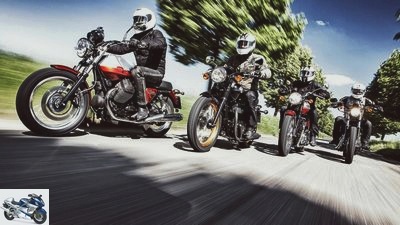
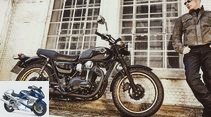
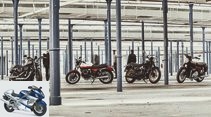
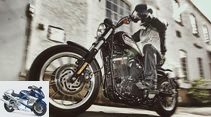
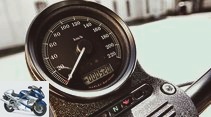
25th photos
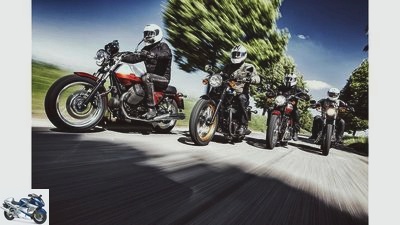
1/25
The retro bikes Harley-Davidson Sportster 883 Roadster, Kawasaki W 800 Special Edition, Moto Guzzi V7 Special and Triumph Bonneville T100 in comparison.
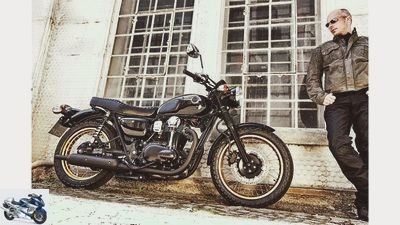
2/25
Kawasaki W 800 Special Edition.
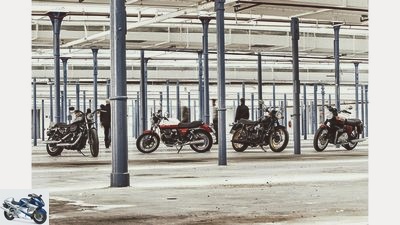
3/25
The classically beautiful shapes of the retro bikes Harley-Davidson Sportster 883 Roadster, Kawasaki W 800 Special Edition, Moto Guzzi V7 Special and Triumph Bonneville T100.
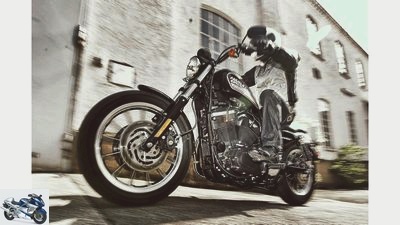
4/25
Harley-Davidson Sportster 883 Roadster: It’s admirable how Harley managed to dampen the vibrations of the 45-degree engine so that only the good vibrations, the pounding and pulsing, remain.
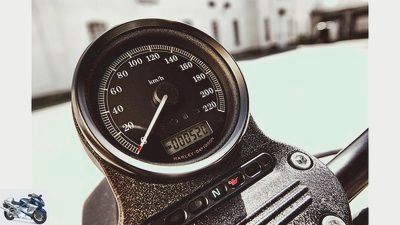
5/25
Harley-Davidson Sportster 883 Roadster: If you don’t feel when it’s time to change gear, you have no business in your saddle.
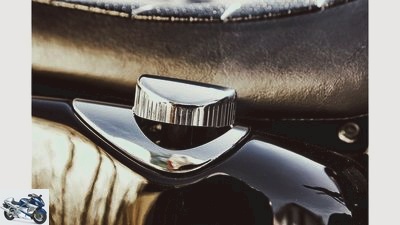
6/25
Harley-Davidson Sportster 883 Roadster: The retractable lid of the oil tank is a typical trademark.
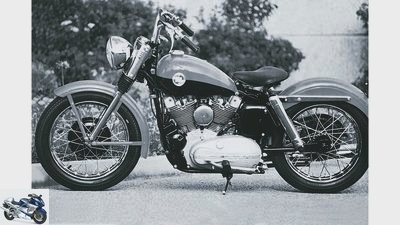
7/25
Harley-Davidson Sportster XL from 1957: The year 1957 was the hour of birth of the 883 cm³ original Sportster engine.
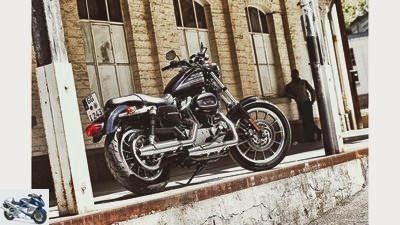
8/25
Harley-Davidson Sportster 883 Roadster.

9/25
Triumph Bonneville T100.

10/25
Harley-Davidson Sportster 883 Roadster, Kawasaki W 800 SE, Moto Guzzi V7 Special and Triumph Bonneville T100.
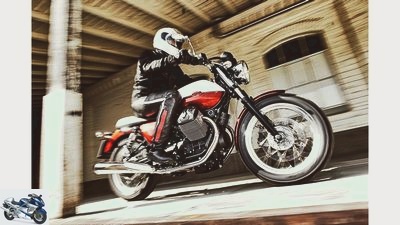
11/25
Moto Guzzi V7 Special: Actually, only Borrani high-shoulder rims are missing and the illusion would be perfect. Driving the Guzzi is not only a sensual experience, but also a short journey through time.
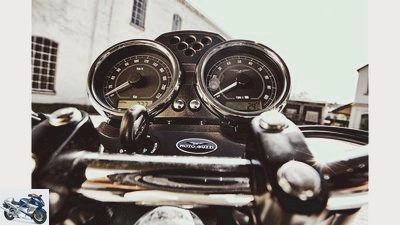
12/25
Moto Guzzi V7 Special: All analog clocks offer an outside temperature display only the V7.
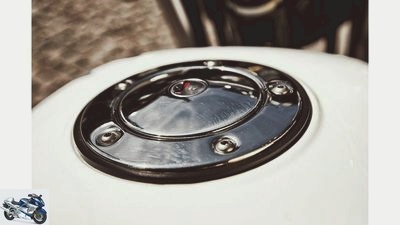
13/25
Moto Guzzi V7 Special: Lovingly fitted, polished aluminum tank cover.
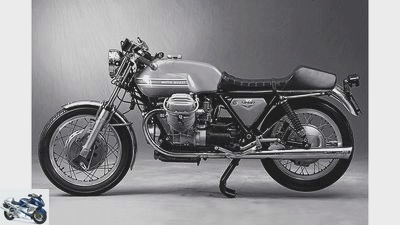
14/25
Moto Guzzi V7 sport from 1971: After the tourist V7 Special from 1966 with 700 cc, the V7 Sport received the three-quarter liter.
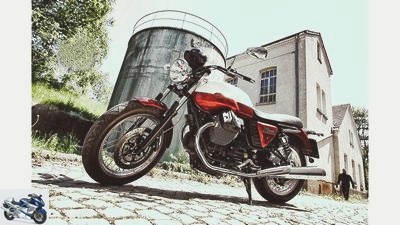
15/25
Moto Guzzi V7 Special.
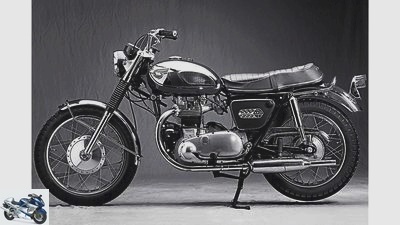
16/25
Kawasaki W1 from 1966: Its design was blatantly based on the BSA A7.
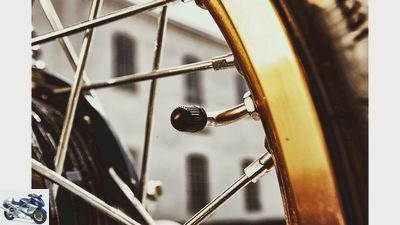
17/25
Kawasaki W 800 SE: angle valve as a little helper.
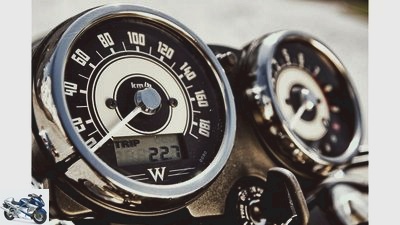
18/25
Kawasaki W 800 SE: Clear and easy to read instruments thanks to the large digits.
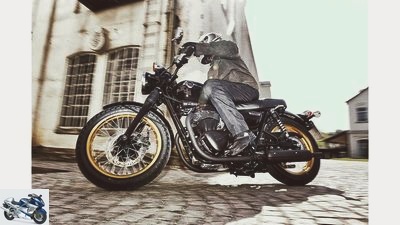
19/25
Kawasaki W 800 SE: Like no other in this test, it carries its driver gently over cobblestones and frost breaks.
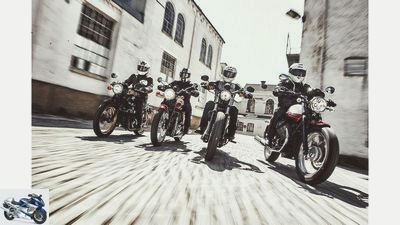
20/25
Harley-Davidson Sportster 883 Roadster, Kawasaki W 800 SE, Moto Guzzi V7 Special and Triumph Bonneville T100 on the road in the streets.
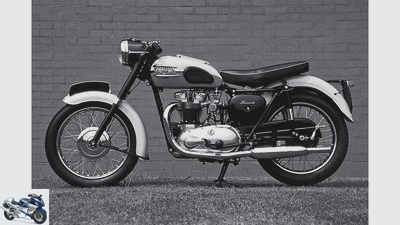
21/25
Triumph Bonneville 650 from 1959: It established the reputation of the sporty and fast Triumph twin.
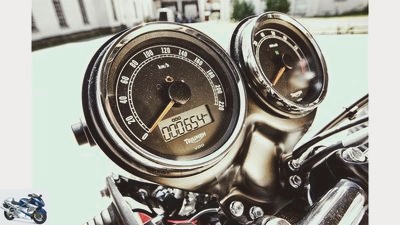
22/25
Triumph Bonneville T100: Instruments in the style of old Smiths watches as the icing on the cake.
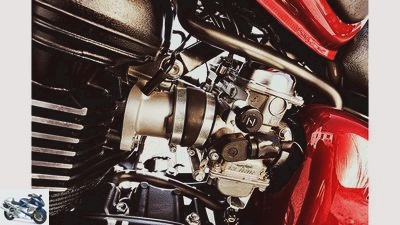
23/25
Triumph Bonneville T100: The injection camouflages itself with a choke lever and carburetor housing – a masterpiece.
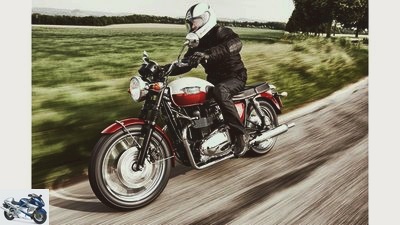
24/25
Triumph Bonneville T100: It plays the role of the sporty roadster with flying colors. Foolproof in handling and, thanks to the powerful motor and gripping single disc in the front wheel, ideally equipped for fast stretches across the country.
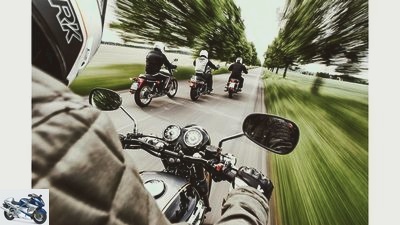
25/25
The retro bikes Harley-Davidson Sportster 883 Roadster, Kawasaki W 800 SE, Moto Guzzi V7 Special and Triumph Bonneville T100 convince each in their own way.
Comparison test: Retro-Bikes 2012
Motorcycles from Harley-Davidson, Kawasaki, Moto Guzzi and Triumph
If the hamster wheel you are in seems to be spinning wilder and wilder, the world is setting an increasingly insane pace when you have to get out, find peace, then these four machines are just the thing.
Wow, she is noble, ”the daughter exclaims before mounting at the sight of the Moto Guzzi V7 Classic. The neighbors, on the other hand, can hardly take their eyes off the Triumph T100. “It’s new and can be bought like this? Unbelievable. ”A few hours and many kilometers later at a dreamy gas station somewhere in the Black Forest, two mature motorcycle fans pause in front of the Kawasaki W 800 Special Edition and agree:“ Man, it looks beautiful! ”And so does the Harley Sportster 883 Roadster , simple, original, reduced to the essentials, earns admiration.
That’s how it goes with the four everywhere. Heads fly around, people’s faces brighten, admiration and enthusiasm meet. What is missing are the usual questions like “How fast?” “How strong?”. Because it is obviously of secondary importance, given the classically beautiful shapes of these retro bikes. -While Triumph and Kawasaki skilfully cite their own past with modern constructions, Harley and Moto Guzzi embody the original concept, which is kept alive but constantly evolving.
S.o Technically, the 90-degree V2 of the Guzzi is still based on the V50 engine from the 1970s. But it was heavily renovated again for 2012 – recognizable by the matt black cylinder heads, which are now replacing the characteristic heads of the small two-valve engines. It should make 51 instead of the previous 49 hp.
Buy complete article
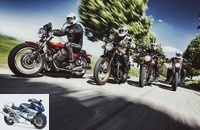
Comparison test: Retro-Bikes 2012
Motorcycles from Harley-Davidson, Kawasaki, Moto Guzzi and Triumph
The retro bikes Harley-Davidson Sportster 883 Roadster, Kawasaki W 800 SE, Moto Guzzi V7 Special and Triumph Bonneville T100 convince each in their own way.
And with the Guzzi, as always, a jolt when starting when the longitudinally lying crankshaft starts moving, throws the whole machine to the right. A full, self-confident rumble escapes the two bags, the first course demands a bit of emphasis, off you go. Anyone who expects glowing descriptions of pithy acceleration, daring bending and vigorous gasping can now turn the pages. Because that’s not what these four do. Her world is the casual gliding, the pleasurable swinging around curves, the enjoyment with all senses and fibers.
First and foremost, however, it is important to be patient: Warm up the engines. Modern air-cooled engines are worlds less demanding than their ancestors, but still require a little more attention than water-cooled ones. However, there is no oil temperature gauge that would make this easier. There are completely different characters who stretch their cooling fins in the airstream. The most rustic is certainly the Harley’s monumental 45-degree twin. By far the longest-stroke engine stomps and hums so devotedly that one would emotionally attest to a significantly larger displacement.
The Evo-Twin shines with the lowest speed level and incredibly even power output. And despite the rather inelastic belt drive, the V2 grips gently and smoothly at the apex of the curve. Push the driver out of the curve as if on a gentle wave, toil leisurely up the speed ladder, accompanied by the ticking of the bumpers. The switching points are set intuitively. Tschak, is the next aisle. Feels like huge massive gears being driven into each other with a powerful hammer blow.
This twin celebrates the smooth gliding on the torque shaft like no other. He leaves nimble and sporty revving up to others. Like triumph. Your engine skilfully imitates its ancestor from the sixties, simulating separate housings for the gearbox and engine, but it is a very modern design. The parallel twin has almost the same displacement as the Harley, but is designed with a much shorter stroke. High speeds are easiest for him to do, he turns the highest and also delivers the most power. On the other hand, however, it can easily be moved just above idle, so that fifth gear is always necessary in the city, only to march forward at the end of the town when turning the bulging throttle grip.
Its wide usable speed range is a boon. On the narrow streets that wind through the Black Forest, this saves some gear changes on the way from curve to curve. In serpentines, the needle of the pretty, old Smiths instrument modeled tachometer is allowed to spin down to just before one, before it marches up the scale again with a bold thrust of gas. The load change jolt is most pronounced with her, but otherwise the manners of the synchronous runner are impeccable. Two balance shafts extinguish vibrations very consistently, which, in connection with the thin sound, makes the engine seem almost a little synthetic, albeit very cultivated.
Which applies in a very similar way to the Kawasaki two-cylinder. A synchronous runner like the Triumph engine, calmed down by a balancer shaft that just leaves it an entertaining amount of vibration in the upper half of the speed. Basically it is a drilled out W 650 drive. The vertical shaft housing is not just a show, but actually houses that exquisite, technically not really necessary, but damn pretty type of camshaft control, which is reminiscent of a low buzzing while driving.
But although it is slightly long, the typical long-stroke pounding and shaking is missing. Thanks to lush centrifugal masses, its working range begins at around 1500 revolutions. From then on it moves forward smoothly and free of load changes as if pulled by a rubber band. Turns even briskly up to over 6000 / min, but then his vigor decreases. Regions like this don’t even have to be visited, because underneath it’s much more entertaining. Only in terms of sound does the W 800 remain rather shy.
Fat sound? Here you go. The Guzzi has it. Smashes her V2 aria confidently like a tenor under a choirboy. Ironically, the displacement dwarf sounds the most full-bodied. The revision did not mobilize the promised additional horses. But that is secondary. Because it has still kept its powerful draft. With a powerful thud, it pushes out of the lower rev range, looks really lively. With every throttle, the tail rises from its springs.
Triumph Bonneville T100: It plays the role of the sporty roadster with flying colors. Foolproof in handling and, thanks to the powerful motor and gripping single disc in the front wheel, ideally equipped for fast stretches across the country.
And although nominally the weakest, it can stand up to the strongest, namely triumph, when it comes to pulling through. Of course, it benefits from the shortest overall translation. Above all, at 199 kilograms, it is by far the lightest of the quartet. The others carry 35 (Triumph), 18 (Kawasaki) and even 67 kilograms (Harley) more with them. So you can enjoy life in a relaxed way with a switching speed of 3000, enjoy the powerful bulls and snorkeling from the exhaust and air filter box. Because you sit comfortably in spite of the pegs that are a bit high for long-legged people, the Guzzi sails through the corners as if it were a matter of course and the brake in the front wheel proves that even a single disc is capable of considerable deceleration. So you could swing the streets for hours. Especially since the huge 22-liter tank enables a range of almost 500 kilometers.
The only downer: the tuning of the struts. Equipped with little compression but a lot of rebound, they quickly go to block, and riding on the rubber buffer is then not really comfortable on short, hard bumps. As a result, the fork lacks leadership in faster corners, which affects the otherwise impeccable stability. The Kawasaki, on the other hand, hovers over well-worn asphalt as if on cloud nine. Their smoothly working spring elements are very carefully devoted to patches and dents in the road surface. In addition, the pilot sits casually and relaxed. The finely padded bench offers a gentle step for support, the flat handlebars are perfectly at hand, and your feet will immediately find the stops where you expect them.
The Kawasaki takes curves as they come. Nonchalantly, it passes bumps in the sloping position. Splendid. A calm, relaxed character. Moved quickly it rocks and bobs in the curves, but it is allowed to. Because the forgiving chassis inspires confidence despite the soft set-up. The roughly profiled Dunlop Roadmasters fit in perfectly with the retro look, but their sporting talents are limited, especially in the wet there is often a lack of grip.
This has to be taken into account as well as the single disc in the front wheel, which goes to work quite unmotivated. The proximity to the original goes a step too far. Little support is to be expected from the drum in the rear wheel. But if you just want to let yourself drift away and clear your head, you have come to the right place with the beautiful W 800. She also sips the most modest of fuel and is the only one to have a main stand and a helmet lock. Those who like to spice up relaxed tours with a dash of sportiness should take a seat in the saddle of the Triumph.
Although not the handiest, their spring elements strike a good balance between firm and comfortable. The Metzeler tires keep pace with the rain, and the single disc in the front wheel shines with crisp deceleration. So when strolling or on a brisk ride everything is actually in butter, some people complain at most about the handlebar ends, which are cranked a little too strongly towards the driver, and the thick rubber grips, which look authentic but give little grip.
And while we’re at it: the bench offers plenty of space, but is as flat as a breakfast board and therefore offers neither driver nor passenger support to the rear. But does one seriously want to accuse such a beauty? So we prefer to enjoy how foolproof it hits the bends, lean back and relax when the twin sets off like a sewing machine and let our gaze over the pretty instruments, the two-tone tank with its off-center fuel cap – an advantage when the Bonnie is on the side stand the pump is standing – wander.
Harley-Davidson Sportster 883 Roadster, Kawasaki W 800 SE, Moto Guzzi V7 Special and Triumph Bonneville T100 on the road in the streets.
With the Sportster Roadster, Harley contributes a terrific everyday decelerator to this quartet. The rumbling, pumping Evo-Twin massages the stomach and soul with gentle pulsing, dissolving any hint of hectic in an instant. The speedometer sits lonely on the fork bridge, speed is secondary here, easy does it. The peanut tank is so narrow that the knees almost touch – and at 12.5 liters it is almost as big as the Kawasaki fuel drum. Only the strangely high pegs add a disturbing undertone to the relaxed arrangement.
The Harley is surprisingly easy to turn with switchbacks. With increasing speed on the open road, however, it becomes stiff in alternating bends and needs some strength to turn. Once on course, it hums extremely stable through the curves and sails unmoved on the path it has taken. The spring elements, especially the fork, parry long bumps very well. It only rumbles indignantly over short successive edges. A total weight of 266 kilos cannot be denied. Then it is better to reduce the speed a little, the lean angle is limited anyway. Whereby the only double disc brake in the test field grips excellently. But if you get on the Harley, you consciously choose the quiet pace – and you will not be disappointed. This ultimately unites them with the other three, who also promise the pure, unfiltered and very original driving experience, detached from performance and measured values. And keep this promise. Each in their own way.
Technical specifications
The retro bikes Harley-Davidson Sportster 883 Roadster, Kawasaki W 800 Special Edition, Moto Guzzi V7 Special and Triumph Bonneville T100 in comparison.
Harley-Davidson Sportster 883 Roadster
Air-cooled two-cylinder 45-degree V-engine, two valves per cylinder, injection, Ø 45 mm, five-speed gearbox, toothed belt, bore x stroke 76.2 x 96.8 mm, 883 cm³, 39.0 kW (53 PS) 5900 rpm, 70 Nm at 3750 rpm, telescopic fork, Ø 39 mm, two-arm swing arm made of steel, double disc brake at the front, Ø 292 mm, disc brake at the rear, Ø 292 mm, tires 100 / 90-19; 150 / 80-16, wheelbase 1520 mm, spring travel f / h 141/104 mm, seat height * 750 mm, weight with a full tank * 266 kg, tank capacity 12.5 liters, price (without ancillary costs) 8295 euros.
Kawasaki W 800 Special Edition
Air-cooled two-cylinder in-line engine, four valves per cylinder, injection, Ø 34 mm, five-speed gearbox, chain, bore x stroke 77.0 x 83.0 mm, 773 cm³, 35.0 kW (48 PS) at 6500 rpm, 60 Nm at 2500 rpm, telescopic fork, Ø 39 mm, two-arm swing arm made of steel, front disc brake, Ø 300 mm, rear drum brake, Ø 160 mm, tires 100 / 90-19; 130 / 80-18, wheelbase 1465 mm, spring travel f / h 130/106 mm, seat height * 800 mm, weight with a full tank * 217 kg, tank capacity 14.0 liters, price (without ancillary costs) 8490 euros.
Moto Guzzi V7 Special
Air-cooled two-cylinder 90-degree V-engine, two valves per cylinder, injection, Ø 38 mm, five-speed gearbox, cardan, bore x stroke 80.0 x 74.0 mm, 744 cm³, 37.0 kW (50 PS) 6200 / min, 58 Nm at 5000 / min, telescopic fork, Ø 40 mm, two-armed swing arm made of aluminum, front disc brake, Ø 320 mm, rear disc brake, Ø 260 mm, tires 100 / 90-18; 130 / 80-17, wheelbase 1449 mm, spring travel f / h 130/118 mm, seat height * 805 mm, weight with a full tank * 199 kg, tank capacity 22.0 liters, price (without ancillary costs) 8490 euros.
Triumph Bonneville T100
Air-cooled two-cylinder in-line engine, four valves per cylinder, injection, Ø 37 mm, five-speed gearbox, chain, bore x stroke, 90.0 x 68.0 mm, 865 cm³, 50.0 kW (68 PS) at 7400 rpm, 68 Nm at 5800 rpm, telescopic fork, Ø 41 mm, two-arm swing arm made of steel, front disc brake, Ø 310 mm, rear disc brake, Ø 255 mm, tires 100 / 90-19; 130 / 80-17, wheelbase 1500 mm, spring travel f / r 120/106 mm, seat height * 780 mm, weight with a full tank * 234 kg, tank capacity 16.0 liters, price (without ancillary costs) 8990 euros.
Related articles
-
Comparison test of V2 character bikes
Bilski Comparison test of V2 character bikes Water, earth, fire, air The ghost in the machine? Nowhere is it as pronounced as in large V2 machines….
-
Comparison test travel enduros
Jahn Comparison test of travel enduros, BMW R 1200 GS Adventure, KTM 990 Adventure, Moto Guzzi Stelvio Travel enduros Their martial look promises…
-
Comparison test of naked bikes BMW R 1150 R Kawasaki ZRX 1200 Suzuki GSF 1200 Bandit
Gragolov Comparison test of naked bikes BMW R 1150 R Kawasaki ZRX 1200 Suzuki GSF 1200 Bandit close friends Those who go upright and unprotected towards…
-
Harley-Davidson Sportster Iron 883 and Harley-Davidson Street 750 in comparison test
www. 25th photos www. 1/25 Harley-Davidson wants to expand its fan base, the Harley-Davidson Street 750 is intended to inspire…
-
Comparison: cool bikes for 8,000 euros
48 photos 1/48 Cool bikes for 8,000 euros: Ducati Monster 696, Harley-Davidson Sportster 883, Triumph Street Triple and Moto…
-
Comparison test: large naked bikes
fact Comparison test: Large naked bikes, BMW K 1300 R, Honda CB 1300 S, Suzuki B-King, Yamaha XJR 1300 Large naked bikes in comparison Content of An…
-
Comparison test: retro bikes 2011
Gargolov Comparison test: retro bikes 2011 Triumph Thruxton versus Moto Guzzi V7 Racer Forever Young? Retro bikes bring history back to life. Two…
-
Eight large touring motorcycles in a comparison test
Photo: 24 photos 1/24 BMW R 1200 GS Rallye, Moto Guzzi Stelvio 1200 8V, Triumph Tiger Explorer, KTM 990 Adventure, Kawasaki…
-
Comparison test touring enduro bikes: Honda Transalp, Kawasaki Versys, Suzuki V-Strom 650
Jahn Comparison test of travel enduro bikes: Honda Transalp, Kawasaki Versys, Suzuki V-Strom 650 Always along the wall Travel enduro doesn’t necessarily…
-
39 photos 1/39 The Triumph Speed Triple: The price 11,740 euros (the test motorcycle with windshield for 245 euros and…